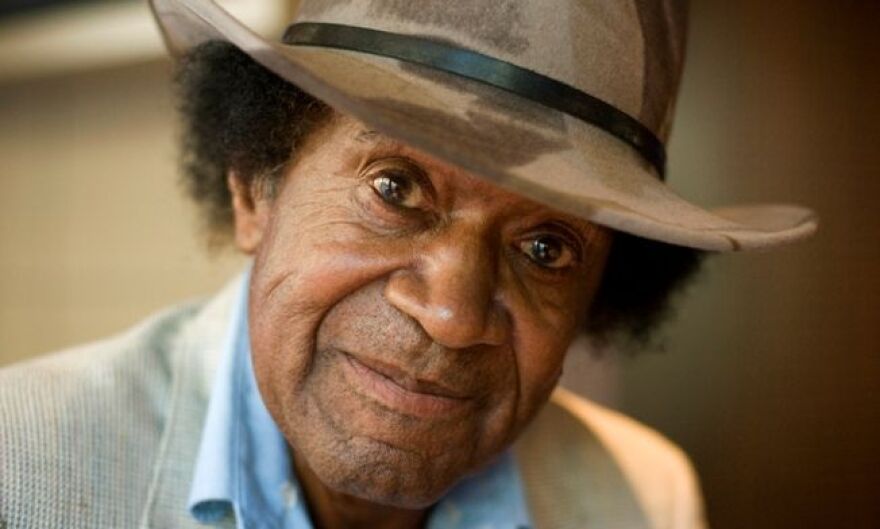Freddie Redd, a pianist and composer who enjoyed an ascendant hard-bop career in the 1950s and early '60s, before slipping into semi-obscurity and a resurgence on various local scenes, died early Wednesday morning in New York City. He was 92.
His grandson Leslie Clarke announced his death on Facebook, without stating a cause.
Redd is best known, in and beyond the jazz community, for composing the score to The Connection, a Jack Gelber play produced Off Broadway in 1959. Later adapted for a film by Shirley Clarke, The Connection paints an unvarnished portrait of heroin addicts waiting for their next fix. Redd and alto saxophonist Jackie McLean appeared in the stage production and the film, as well as the soundtrack. Among its enduring Redd compositions is "Who Killed Cock Robin?" (which can be heard in this trailer).
The Music From 'The Connection' was Redd's first acclaimed album for Blue Note, followed in 1961 by Shades of Redd, featuring a band with McLean, Tina Brooks on tenor saxophone, Paul Chambers on bass and Louis Hayes on drums.
Writing in the New York Times in 1989, Peter Watrous noted that Shades of Redd struck a somewhat traditional chord in the era of Ornette Coleman and Cecil Taylor. "But the album is so accomplished and satisfying," he adds, "that it proves that a genre — in this case hard-bop — can still be fertile long after its historical moment has passed."
The example Watrous provides is Redd's opening track, "The Thespian." It's no less evident on a subtly intricate shuffle titled "Melanie."
Born on May 29, 1928, in Harlem, Freddie Redd was raised by a single mother, and began playing the piano at an early age. He was self-taught, and proudly so.
Redd served in the Army during the Korean War, and while abroad he got his first taste of bebop — Charlie Parker and Dizzy Gillespie's Shaw 'Nuff — and was instantly hooked. He returned to New York on his discharge in 1949, and quickly fell into the jazz scene, working with Cootie Williams, Art Blakey, Charles Mingus and others.
On piano, Redd was never the most dynamic improviser, but his keen ear and deep attunement to song form made him a striking "A busy chorder, he will start rattling away behind a soloist, prompting him and prodding hard," Watrous wrote. "Chords jar and fragment. New rhythmic and harmonic ideas pop up regularly."
 Francis Wolff
Francis WolffThe Connection provided a unique career opportunity for Redd, as well as a groundbreaking dramatic innovation. At one point in the play, a character says the police are on the way. In the script, they never do, but one night they did.
"A knock came on the door," Redd told NPR's Morning Edition in 2012, "and when the gentleman who was the head actor [playing the character] Leach, he opened the door, there was a real uniformed policeman there. Jackie McLean had gotten the policeman on the beat to come up and stand there. So we all thought we were being busted."
Redd recorded a third album, Redd's Blues, for Blue Note in 1961, but producer Francis Wolff decided not to release it at the time. It finally saw daylight in 1988. By then, Redd's career had taken a downward turn: he'd moved to Europe in the '70s, then to the San Francisco Bay Area, where he became a local stalwart. He released dozens of albums, on labels including Milestone and Steeplechase.
A decade ago, Redd moved to Baltimore, establishing a presence there and in Washington, D.C. He formed relationships with locals like saxophonist Brad Linde, who features Redd on a pair of new albums, Baltimore Jazz Loft and Reminiscing.
"Playing with Freddie gave me the same feeling as listening to his music," Linde tells WBGO. "It was joyful, toe-tapping, and supremely lyrical. His melodies (composed or improvised) were thoughtful, his harmonies wholly original and inevitable, and his touch was crisp and clear."
He adds: "The highlight for me was his comping. He was constantly composing his accompaniment. His left hand was full of counterpoint, pedal points, and voice-leading surprises. His right hand would alternate block chords with independent conversations with the soloist and blues inflections. After each solo, he'd wait to catch my eye, grinning and nodding in approval before taking his own solo. He was a consummate composer and an authentic gem from the heyday of bebop."




